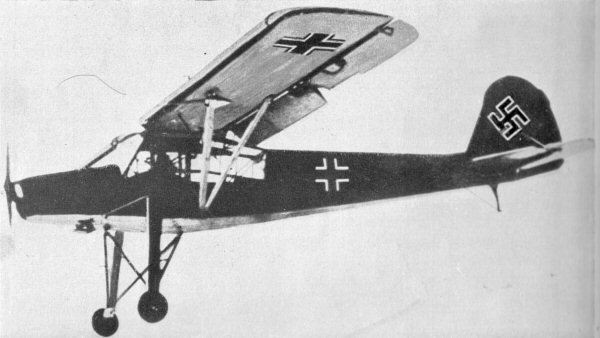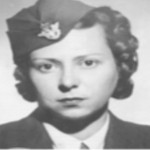
Fiesler Fi 156 (Stork)
The Fieseler Fi 156 Storch (English: Stork) was a small German liaison aircraft built by Fieseler before and during World War II.
About Fiesler Fi 156 (Stork) – Source Wikipedia
Role: Reconnaissance and communications
Manufacturer: Fieseler, Morane-Saulnier
Designers: Gerhard Fieseler, Reinhold Mewes, Erich Bachem
First flight: 24 May 1936
Introduction: 1937
Status: Retired 1945 (Germany), 1970 (France)
Primary users: Luftwaffe, Aviation Légère de l’Armée de Terre, Armée de l’Air
Number built: Over 2,900
Specifications (Fi 156)
General characteristics
- Crew: Two
- Length: 9.9 m (32 ft 6 in)
- Wingspan: 14.3 m (46 ft 9 in)
- Height: 3.1 m (10 ft 0 in)
- Wing area: 26 m² (280 ft²)
- Empty weight: 860 kg (1,900 lb)
- Loaded weight: 1,260 kg (2,780 lb)
- Powerplant: 1 × Argus As 10 air-cooled inverted V8 engine, 180 kW (240 hp)
Performance
- Maximum speed: 175 km/h (109 mph) at 300 m (1,000 ft)
- Range: 380 km (210 nmi, 240 mi)
- Service ceiling: 4,600 m (15,090 ft)
- Rate of climb: 4.8 m/s (945 ft/min)
- Wing loading: 48.5 kg/m² (9.9 lb/ft²)
- Power/mass: 143 W/kg (0.087 hp/lb)
Armament
- Guns:MG 15 machine gun

Fiesler Fi 156 (Stork)
The Fieseler Fi 156 Storch (English: Stork) was a small German liaison aircraft built by Fieseler before and during World War II.
The Fieseler Fi 156 Storch (English: Stork) was a small German liaison aircraft built by Fieseler before and during World War II. Production continued in other countries into the 1950s for the private market. It remains famous to this day for its excellent STOL performance; French-built later variants often appear at air shows.
Conception and production
Design and development
In 1935, the RLM (Reichsluftfahrtministerium, Reich Aviation Ministry) invited tenders from several companies for a new Luftwaffe aircraft suitable for liaison, army co-operation (today called Forward Air Control), and medical evacuation. This resulted in the Messerschmitt Bf 163 and Siebel Si 201 competing against the Fieseler firm’s tender. Conceived by chief designer Reinhold Mewes and technical director Erich Bachem, Fieseler’s design had a far better STOL (Short Take Off and Landing) performance. A fixed slat ran along the entire length of the leading edge of the long wings, while a hinged and slotted flap ran along the entire length of trailing edge. This was inspired by earlier 1930s Junkers “double-wing” aircraft wing control surface designs, including the ailerons.
A design feature rare for land-based aircraft, enabled the wings on the Storch to be folded back along the fuselage in a manner similar to the wings of the US Navy’s F4F Wildcat fighter. This allowed the aircraft to be carried on a trailer or even towed slowly behind a vehicle. The primary hinge for the folding wing was located in the wing root, where the rear wing spar met the cabin. The long legs of the main landing gear contained oil-and-spring shock absorbers that had a travel of 450 mm (18 inches), allowing the plane to land on comparatively rough and uneven surfaces. In flight the landing gear legs hung down, giving the aircraft the appearance of a long-legged, big-winged bird, hence its nickname, Storch. With its very low landing speed the Storch often appeared to land vertically, or even backwards, in strong winds from directly ahead.
German production
About 2,900 Fi 156s, mostly Cs, were produced from 1937 to 1945 at the Fieseler Factory in Kassel. In 1942 production started in the Morane-Saulnier factory at Puteaux in France. Due to the demand for the Bf 109 and the Fw 190, Storch production was shifted to the Leichtbau Budweis in Budweis in 1943.
Czech production
In 1944 production was moved from the Leichtbau Budweis to the Mráz factory in Chocen which produced 138 examples of Fi 156, locally designated as K-65 Čáp. Production ended in 1949.
French production
Immediately after the liberation of France in 1944, the production of Storch at the Morane-Saulnier factory was continued at the request of the Armée de l’Air and designated MS 500 for the batch of aircraft produced with the remaining stock of Argus engines. Further modification and use of different engines (inline and radial) are known under different type. The use of the plane in Indochina highlighted the weakness of the wood in the construction of the airframe; it was then decided to build the wings in metal. Among the modifications, the defensive weapon aiming through the back window was dropped, although some aircraft have then been modified on the field to take a machine gun MAC 34T firing through one of the side windows. 141 aircraft were built before the end of World War II and a total of 925 aircraft were built before the end of the production of all type of Criquet by Morane-Saulnier in 1965.
Romanian production
Licence production was also started in Romania in 1943 at the ICAR factory in Bucharest. Only 10 were built by the time Romania switched sides, with a further 70 aircraft being built by the Romanians before production ended in 1946.[2]
Modern development
Because of its superb STOL characteristics, there have been many attempts to recreate or copy the Storch, namely in the form of various homebuilt aircraft such as the Pazmany Stork and Roger Mann’s Ragwing Stork. Another is the Slepcev Storch designed by Nestor Slepcev. It is a ¾ scale reproduction of the original with some simplifications. The use of modern materials provides better STOL performance than the original with a take-off run of 30 m and landing-roll of 50 m with no headwind.[3]
Operational history
During WWII
The Storch was deployed in all European and North African theaters of World War II. But it is probably most famous for its role in Operation Eiche, the rescue of deposed Italian dictator Benito Mussolini from a boulder-strewn mountain-top near the Gran Sasso. Even though the mountain was surrounded by Italian troops, German commando Otto Skorzeny and 90 paratroopers parachuted onto the peak and quickly captured it. But the problem remained of how to get back off. A Focke-Achgelis Fa 223 helicopter was sent, but it broke down en route. Instead, pilot Walter Gerlach flew in a Storch. It landed in 30 m (100 ft), and after Mussolini and Skorzeny boarded, it took off in 80 m (250 ft), even though the plane was overloaded. The Storch involved in rescuing Mussolini bore the radio code letters, or Stammkennzeichen, of “SJ + LL” in the motion picture coverage of the daring rescue.
On 26 April 1945 a Storch was one of the last planes to land on the improvised airstrip in the Tiergarten near the Brandenburg Gate during the Battle of Berlin and the death throes of the Third Reich. It was flown by the test pilot Hanna Reitsch, who flew Generalfeldmarschall Robert Ritter von Greim from Munich to Berlin to answer a summons from Hitler. Once in Berlin von Greim was informed that he was to take over command of the Luftwaffe from Hermann Göring.[4]
A Storch was the victim of the last dog fight on the Western Front and another was downed by a direct Allied counterpart of the Storch, an L-4 Grasshopper. The pilot and co-pilot of the L-4, Lieutenants Duane Francis and Bill Martin, opened fire on the Storch with their .45 caliber pistols, forcing the German air crew to land and surrender.
Field Marshal Rommel used Storch aircraft for transport and battlefield surveillance during the North African desert campaign of World War II.
During the war a number of Störche were captured by the Allies. One became the personal aircraft of Field Marshal Montgomery. Others were used as the personal aircraft of Air Vice Marshal Arthur Coningham and Air Vice Marshal Harry Broadhurst, who acquired his Storch in North Africa, and flew it subsequently in Italy and North-West Europe.
The British captured 145, from which 64 were given to the French as war compensation from Germany.
Post WWII:
The ALA and the ALAT use the Criquet from 1945 to 1958 throughout the Indochina War and the Algerian War. The Swiss Air Force and other mountainous European countries continued to use the Storch for rescues in terrain where STOL performance is necessary. Many Storchs are still operational today commonly shown at air shows.
Variants:
- Fi 156 V1: Prototype equipped with an adjustable metal propeller, registration D-IKVN (produced in 1935-1936)
- Fi 156 V2: Prototype equipped with a Wooden propeller. First Prototype to fly (May 10, 1936). registration D-IDVS (produced in 1935-1936)
- Fi 156 V3: Prototype identical to the V2. Test machine for various radio equipment, registration D-IGLI (produced in 1936)
- Fi 156 V4: Prototype identical to the V3. Skis for landing gear and disposable auxiliary tank. (produced in 1936-1937)
- Fi 156 V5: Production prototype for A-series. (produced in 1937)
- Fi 156 A-0: Pre-production aircraft, identical to the V3. Ten aircraft were produced. (produced in 1937-1938)
- Fi 156 A-1: first production models for service, ordered into production by the Luftwaffe with an order for 16 aircraft, the first production aircraft entered service in mid-1937. Some source cite only 6 were effectively produced. (produced in 1938)
- Fi 156 B: Allowed for the automatic retraction of the leading edge slats and had a number of minor aerodynamic cleanups, boosting the speed to 208 km/h (130 mph). The Luftwaffe didn’t consider such a small difference to be important and the Fi-156 B was not produced.
- Fi 156 C-0: Pre-production. Essentially a “flexible” version of the A model. (produced in 1939)
- Fi 156 C-1: three-seater liaison version. (produced in 1939-1940)
- Fi 156 C-2: two-seat observation type (which had a rear-mounted MG 15 machine gun for defense), produced in 1940.
- Fi 156 C-3: Replaced the C-1 and C-2 with a “universal cockpit” suited for any role. (produced in 1940-1941)
- Fi 156 C-3/Trop: Version adapted for tropical/desert conditions. Filtered intakes. (produced in 1940-1942)
- Fi 156 C-5: Addition of a belly hardpoint for a camera pod or jettisionable auxiliary tanks. Some were fitted with skis, rather than wheels, for operation on snow. (produced in 1941-1945)
- Fi 156 C-5/Trop: Version adapted for tropical/desert conditions. Filtered intakes. (produced in 1941-1945)
- Fi 156 D-0: Pre-production of the air ambulance version of the C model with a larger cockpit and larger doors. Powered by an Argus AsP engine. (produced in 1941)
- Fi 156 D-1: Production version of the D-0. (produced in 1942-1945)
- Fi 156 E-0: Liaison version identical to the C-1 Ten pre-production aircraft were fitted with tracked landing gear. (produced in 1941-1942)
- Fi 156 F or P: Counter insurgency version. Identical to the C-3 with machine guns in side windows and bomb-racks/smoke laying. (produced in 1942)
- Fi 156 U: Anti-submarine version. Identical to the C-3 with depth charge. (produced in 1940)
- Fi 156 K-1: Export version of the C-1 (Bought by Sweden).
- Fi 256: A five seat civil version; two were built by Morane-Saulnier.
- MS-500: Liaison version. French produced with 240 hp French built Argus engine.
- MS-501: with a 233 hp Renault 6Q
- MS-502: Liaison version. Identical to the MS-500, with the Argus engine replaced by a 230 hp Salmson 9ab radial engine.
- MS-504: with a 304 hp Jacobs R-755-A2 radial engine.
- MS-505: Observation version of the MS-500 with the Argus engine replaced by a 304 hp Jacobs R-755-A2 radial engine.
- MS-506: with a 235 hp Lycoming engine.
- Mráz K-65 Čáp: production in Czechoslovakia after World War II.
- Antonov OKA-38 Aist: An unlicensed Soviet copy of the Fi 156, powered by a copy of a Renault MV-6 inverted, air-cooled straight-6 engine, was starting production as the factory was overrun by German forces in 1941

Fiesler Fi 156 (Stork)
The Fieseler Fi 156 Storch (English: Stork) was a small German liaison aircraft built by Fieseler before and during World War II.






